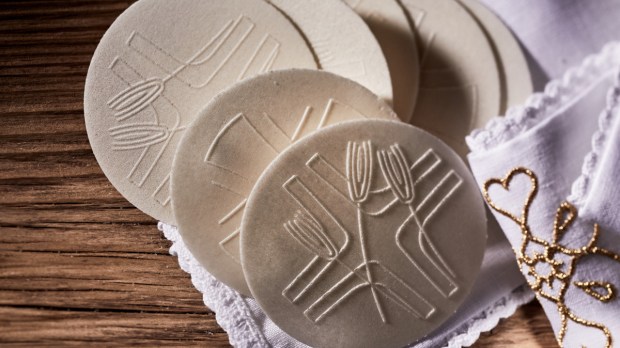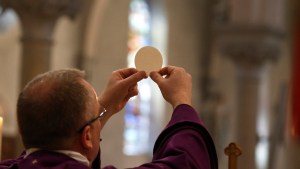The Gospels are clear, after all: At the Last Supper, Jesus “took bread.” Of course, we know full well that what Jesus used must have been unleavened bread, a symbol of the Passover (a piece of information which, however, has not stopped numerous artists from painting the Last Supper imaginatively depicting an ordinary leavened loaf in Christ’s hands). Yet, unleavened bread and Communion wafers are not exactly the same thing, nor do they look exactly the same. So when (and why) did the custom of using those small, light-colored wafers during liturgical celebrations arise?
The custom is certainly ancient, but not from the early Christian era: Priests in the early centuries consecrated ordinary leavened loaves, which were then distributed to the faithful in small chunks. But then, when did modern wafers originate?
To answer this question, we could resort to a silly legend or some historical consideration. And since legends are always captivating, we will begin by giving space to the first option, before turning to the second for a more rigorous answer.
The wafers: Invented by a monk who had made a resolution for Advent (says the legend)
The protagonist of our story is St. Wandregisel, the monk who eventually founded the French abbey of Fontanelle. At the time when our friend lived (i.e., in the first half of the 7th century), the noble family that had given him birth was considered important, but no more so than many others: In hindsight, it might be interesting to point out that Wandregisel’s paternal uncle was the progenitor of the Carolingian dynasty. But, unaware of the honors with which his family would one day be covered (and frankly disinterested even in those he could already benefit from), Wandregisel had opted for a life of penance and mortification, donning the monk’s habit.
The legend tells how the cleric had been charged with preparing the loaves that would be consecrated during the Christmas Mass. It was the middle of winter, and it was the coldest December in memory. A few weeks earlier, at the beginning of Advent, Wandregisel had made a resolution to endure the frost without doing anything to warm himself, offering that mortification for the expiation of his sins and for the sake of the Holy Church.
So, when the monk was instructed to set himself at the stove to prepare the loaves for Communion, he found himself in a difficult situation: How could he do so, without enjoying the warmth of the oven, which he had promised to give up? Certainly, he couldn’t refuse the assignment he had received (for mortifications must have an effect on those who choose them without affecting the unfortunates who live with him, creating a chain reaction of logistical problems); yet, Wandregisel would have preferred to find a way not to have to break that Advent resolution, which was bringing him so many benefits.
After turning the problem over in his mind, the monk had the idea of equipping himself with long iron tongs, similar to those blacksmiths used to handle glowing-hot objects in the forge. He attached to the tongs two metal plates suitable for holding the mixture of flour and water; and thus, wielding the long handle of that instrument, and standing at a safe distance from the fireplace, the ascetic managed to bake hundreds of loaves of bread without getting even a little warm.
There was one complication: Rather than loaves of bread, crackers emerged from the oven. Compressed by the tongs, the bread was crushed to become round and flat, resulting in a crispy wafer. But the result didn’t displease the monks of the abbey at all, who in fact greatly appreciated that new type of bread, which kept for a long time and was easy to store. Within a few years, Wandregisel’s discovery had gained such acceptance that it became the norm for the whole of Catholicism: and all because of a monk who had been unwilling to break his Advent resolution!
The spread of hosts in Carolingian Europe
The story of Wandregisel is just a legend – one that, however, has a basis of verisimilitude, at least from the point of view of chronology. The French monk died in 665, and it was precisely at the end of that century that the idea that the bread to be consecrated during Mass should preferably be flat and unleavened slowly began to take hold in French dioceses. Most likely it was not Wandregisel who invented the first Communion wafers, but rather some of his “colleagues” who lived at about the same time and in the same area who devised them.
During the 8th century, the custom of consecrating hosts began to spread gradually but inexorably. In 798, Alcuin of York spoke in their favor, emphasizing their resemblance to the unleavened bread that Jesus had consumed at the Last Supper. A few years later, St. Rabanus Maurus pointed out that the Old Testament explicitly forbade, in no uncertain terms, the use of leavened bread for sacrifices. Of course, the New Covenant had enabled Christians to leave behind many Old Testament prohibitions, but the saint from Mainz was still of the view that Communion wafers, being free of leaven, were to be preferred in that context.
By the 9th century, the custom must have been well established: Numerous liturgists seem to take it for granted, and ecclesiastical archives begin to keep track of the massive purchase of wafer molds, often decorated in such a way as to imprint sacred-themed images on the wafer. Even more significantly, the writings of the 10th and 11th centuries record for us the protests of some “traditionalists” (the most ardent of whom was Eccard IV of St. Gallen) who did not appreciate this innovation and would have liked to continue to consecrate the usual leavened loaves; and it is precisely these isolated criticisms that allow us to guess how widespread the new practice was already at the time.
Eccard notwithstanding, wafers established themselves with ease throughout the Western Church. They were prepared exclusively by clergymen, in a solemn ritual that some might even describe as having a “sacred flavor”: Grains were selected grain by grain, poured into sacks specially created for this use and ground in religious silence by monks who took advantage of those moments to pray. The cooking, by contrast, was accompanied by the chanting of prayers and sacred hymns: and then the wafers were ready to be taken to the abbey and distributed to the churches that requested them.
Like little white coins to enrich the soul
These were not yet the wafers we know today: judging from what the period sources write, everything leads us to imagine that those first wafers for liturgical use still retained the diameter of the loaves to be brought to the table. We know, for example, that it was customary to stack them on top of the Mass chalice (which evidently assumes that the wafers were wider than the cup); some sources tell us of Eucharistic breads that were even large enough to provide fragments for entire weeks from the time they were broken.
Soon, however, they realized that the consistency of the wafers made them extremely crumbly: to avoid the possibility that, in breaking the bread repeatedly, small fragments might be accidentally dispersed, the monks felt the need to switch to a single-portion format, so to speak. Thus were born the small round wafers that we still receive today at Communion; and even in this case, some moralists arched their eyebrows: seen from a distance, those wafers looked like coins, more suited to a money-changer’s counter than to a place of prayer.
But that criticism was soon reinterpreted in a positive light. In the 12th century, the theologian Honorius of Autun pointed out that the comparison was entirely appropriate; and indeed, it was symbolic that the name of God was imprinted on the hosts, in the same way that the name of the reigning king was imprinted on earthly coins. The analogy was perfect and full of symbolism, in the theologian’s judgment: even the hosts, in their own way, are coins, which are generously dispensed by the heavenly King. They are coins for real, and among the most precious ones: the only ones through which one can enjoy the privilege of being face to face with God.



